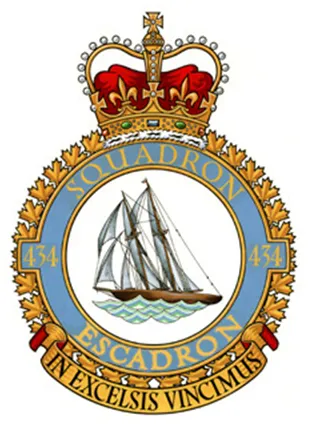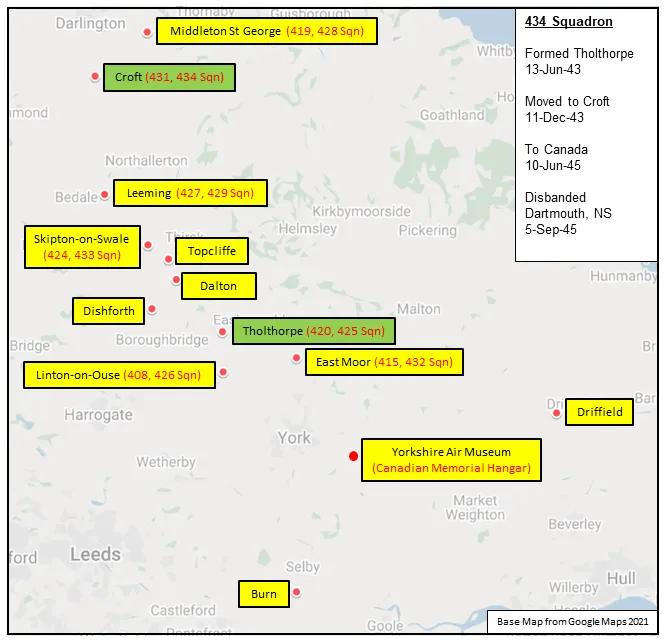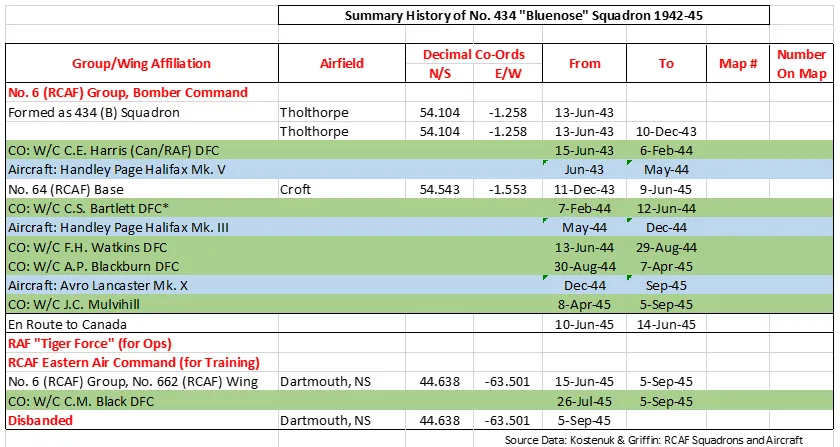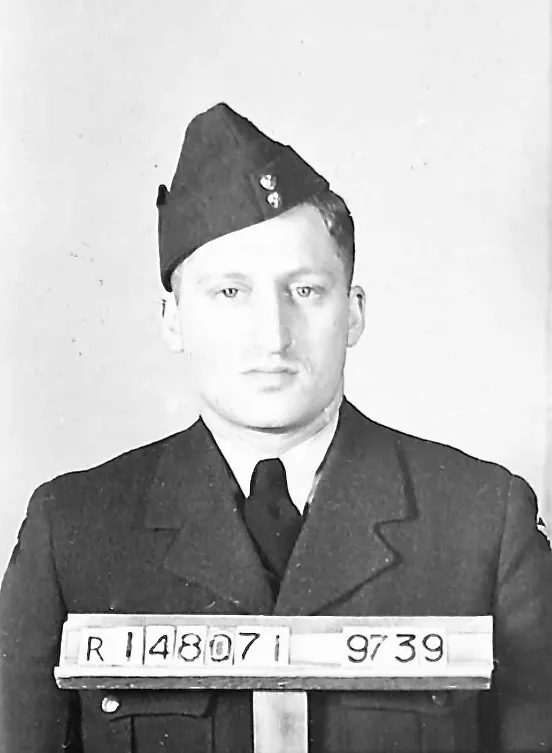434 (B) Sqn In Excelsis Vincimus ("Bluenose")
History of the Squadron during World War II (Aircraft: Halifax V, III, Lancaster I, III)

The unit was first formed at RAF Tholthorpe, Yorkshire, UK  on 13 June 1943, flying the Handley Page Halifax Mk V aircraft. It was the 31st squadron and the 13th Bomber unit formed overseas. From its initiation it was part of the No 6 (RCAF) Group of RAF Bomber Command. On 13 August 1943 it flew its first operational sortie, a bombing raid across the Alps to Milan, Italy. In May 1944 the unit received Halifax Mk IIIs to replace its Mk Vs. The squadron was adopted by the Rotary Club of Halifax, Nova Scotia and to show its connection to the city adopted the nickname "Bluenose Squadron", the common nickname for people from Nova Scotia and a tribute to the schooner Bluenose; an image of the schooner appears on the squadron badge.
on 13 June 1943, flying the Handley Page Halifax Mk V aircraft. It was the 31st squadron and the 13th Bomber unit formed overseas. From its initiation it was part of the No 6 (RCAF) Group of RAF Bomber Command. On 13 August 1943 it flew its first operational sortie, a bombing raid across the Alps to Milan, Italy. In May 1944 the unit received Halifax Mk IIIs to replace its Mk Vs. The squadron was adopted by the Rotary Club of Halifax, Nova Scotia and to show its connection to the city adopted the nickname "Bluenose Squadron", the common nickname for people from Nova Scotia and a tribute to the schooner Bluenose; an image of the schooner appears on the squadron badge.
The squadron moved to RAF Croft, Yorkshire  in December 1943 and re-equipped with Avro Lancaster Mk Is and Mk Xs in December 1944. After VE Day the squadron was earmarked for the Tiger Force to carry on the war against Japan, but was never deployed to the Far East because of the Japanese surrender. The unit was disbanded at Dartmouth, Nova Scotia
in December 1943 and re-equipped with Avro Lancaster Mk Is and Mk Xs in December 1944. After VE Day the squadron was earmarked for the Tiger Force to carry on the war against Japan, but was never deployed to the Far East because of the Japanese surrender. The unit was disbanded at Dartmouth, Nova Scotia  on 5 September 1945.
on 5 September 1945.
During World War II the unit flew 198 missions, including 179 bombing, 17 mine laying, one diversionary and one sea search. This was made up of a total of 2582 individual aircraft sorties, including 45 prisoner of war airlift sorties. It flew 14,622 operational flying hours and dropped 10,358 tons of bombs plus 225 mines. The squadron accounted for seven enemy aircraft destroyed along with two probable and four damaged. 434 Squadron suffered 75 aircraft lost, 484 aircrew operational casualties, including 34 killed, 313 presumed dead, 121 made prisoners and 16 who evaded capture and escaped. Unit personnel received six bars to the Distinguished Flying Cross, 108 DFCs, six Distinguished Flying Medals, one British Empire Medal and seven Mentions in Despatches. Battle Honours were: English Channel and North Sea 1943-44, Baltic 1943-44, Fortress Europe 1943-44, France and Germany 1944-45, Biscay Ports 1944, Ruhr 1943-45, Berlin 1943-44, German Ports 1944-45, Normandy 1944, Rhine.Wikipedia, Kostenuk &Griffin .
 Squadron History (Bomber Command Museum PDF)
Squadron History (Bomber Command Museum PDF)
Maps for Movements of 434 Squadron 1943-45

434 Squadron History Summary 1943-45

History of the Squadron Post-WWII (Aircraft: Sabre 2, 5, 6, Starfighter, Freedom Fighter, Challenger)
The squadron was re-formed as a fighter unit at Uplands, Ontario  on 1 July 1952, flying Canadiar Sabre aircraft. It joined No.3 (Fighter) Wing at Zweibrücken, Germany
on 1 July 1952, flying Canadiar Sabre aircraft. It joined No.3 (Fighter) Wing at Zweibrücken, Germany  in March 1953. It was selected to be one of the eight squadrons to be equipped with the CF-104 Starfighter in a Strike Attack role. Accordingly, it was deactivated on 15 January 1963 and reactivated on 8 April. The squadron was deactivated on 1 Mar 1967.
in March 1953. It was selected to be one of the eight squadrons to be equipped with the CF-104 Starfighter in a Strike Attack role. Accordingly, it was deactivated on 15 January 1963 and reactivated on 8 April. The squadron was deactivated on 1 Mar 1967.
The unit was re-formed as 434 Operational Training Squadron at CFB Cold Lake, Alberta  on 15 February 1968 as the operational training unit for the Canadair CF-5 Freedom Fighter. The squadron later gave up its OTU duties to 419 Squadron and became an operational squadron, moving to CFB Bagotville
on 15 February 1968 as the operational training unit for the Canadair CF-5 Freedom Fighter. The squadron later gave up its OTU duties to 419 Squadron and became an operational squadron, moving to CFB Bagotville  on 15 July 1982, later moving to CFB Chatham
on 15 July 1982, later moving to CFB Chatham  in July 1985. It was again disbanded on 17 March 1989. The unit was again re-formed as 434 Composite Squadron at CFB Shearwater
in July 1985. It was again disbanded on 17 March 1989. The unit was again re-formed as 434 Composite Squadron at CFB Shearwater  on 4 July 1992. The name was changed to 434 Combat Support Squadron and the unit moved to CFB Greenwood
on 4 July 1992. The name was changed to 434 Combat Support Squadron and the unit moved to CFB Greenwood  in mid-1995, flying the CC-144 Challenger and Canadair CT-133 Silver Star in the electronic warfare role. The squadron was once again disbanded there in May 2000.
in mid-1995, flying the CC-144 Challenger and Canadair CT-133 Silver Star in the electronic warfare role. The squadron was once again disbanded there in May 2000.
The squadron was reactivated in May 2018 at CFB Trenton  as a test and evaluation unit. For details see
as a test and evaluation unit. For details see




 Canadian Virtual War Memorial
Canadian Virtual War Memorial Library and Archives Canada Service Files (may not exist)
Library and Archives Canada Service Files (may not exist) RCAF Government website
RCAF Government website